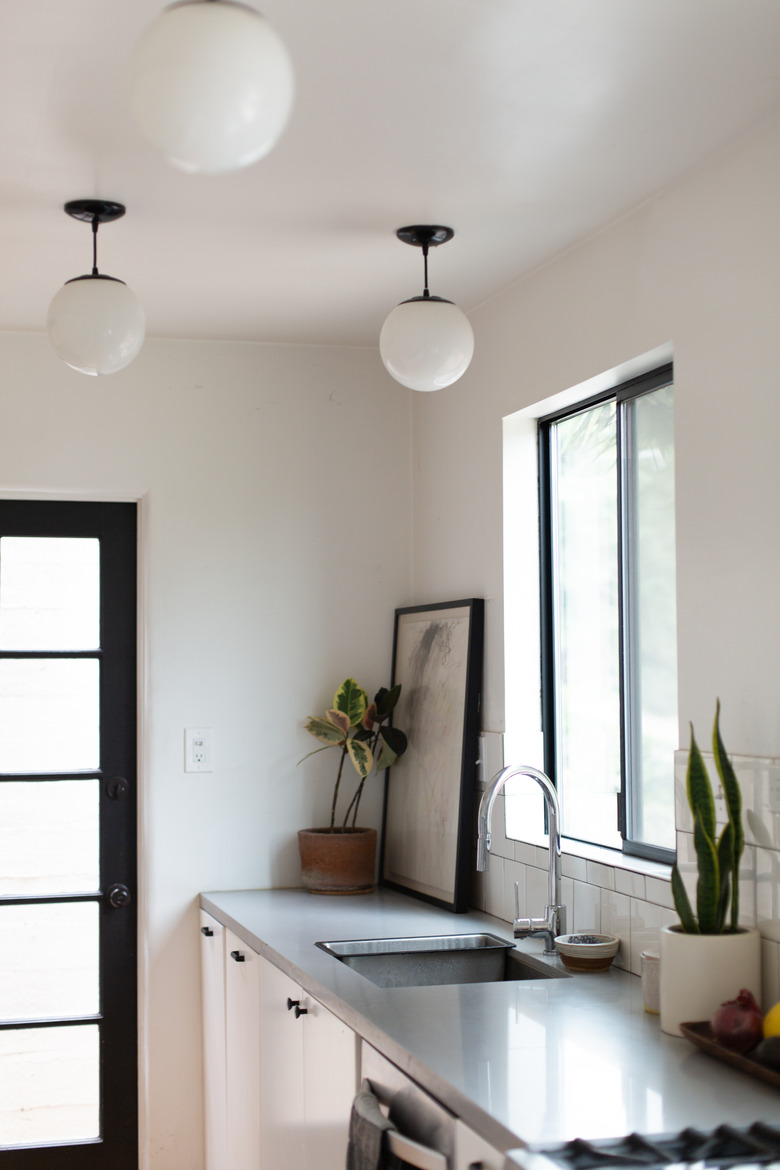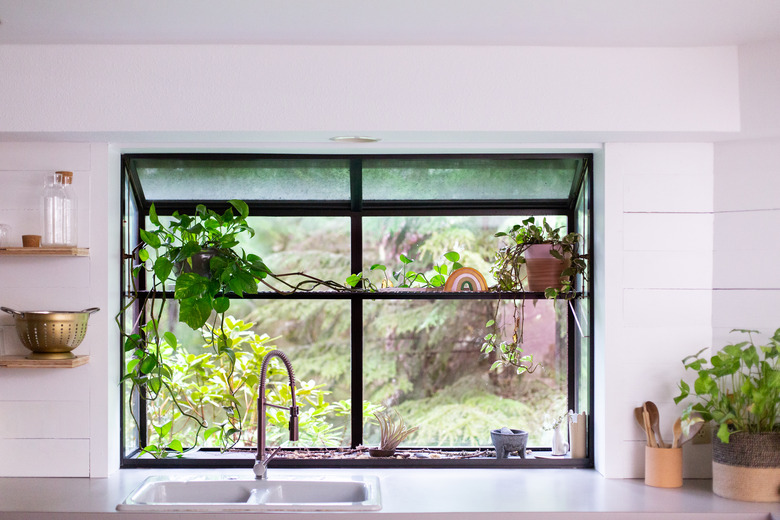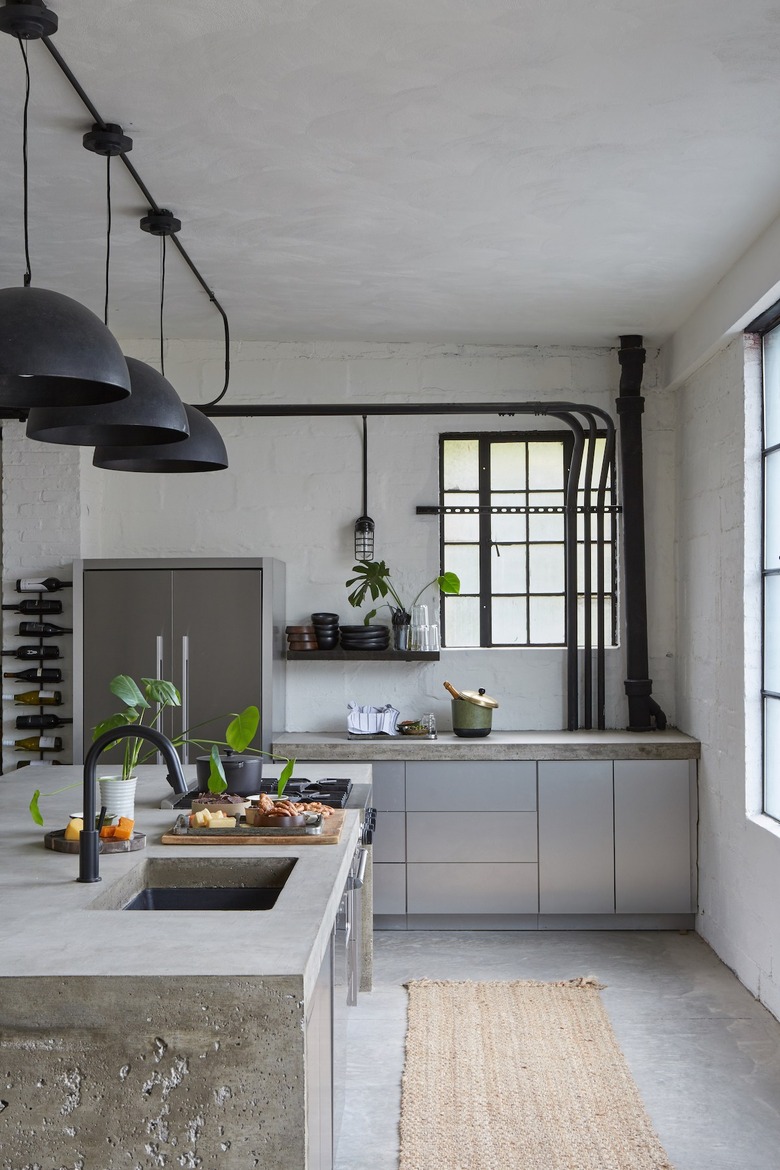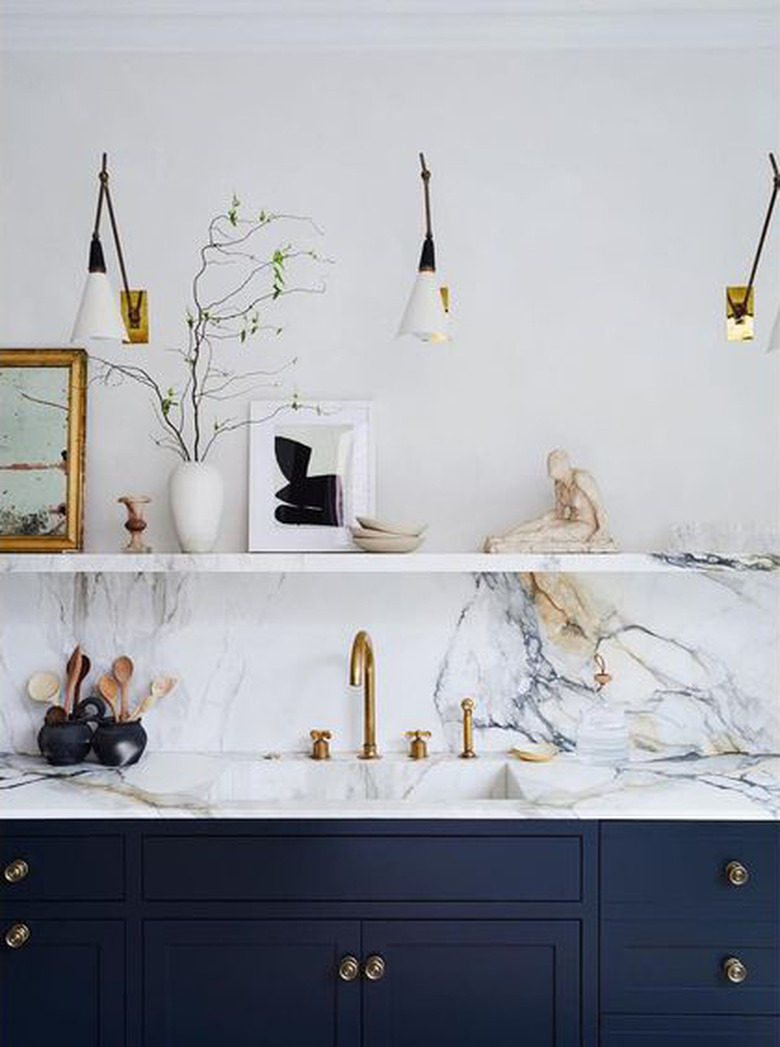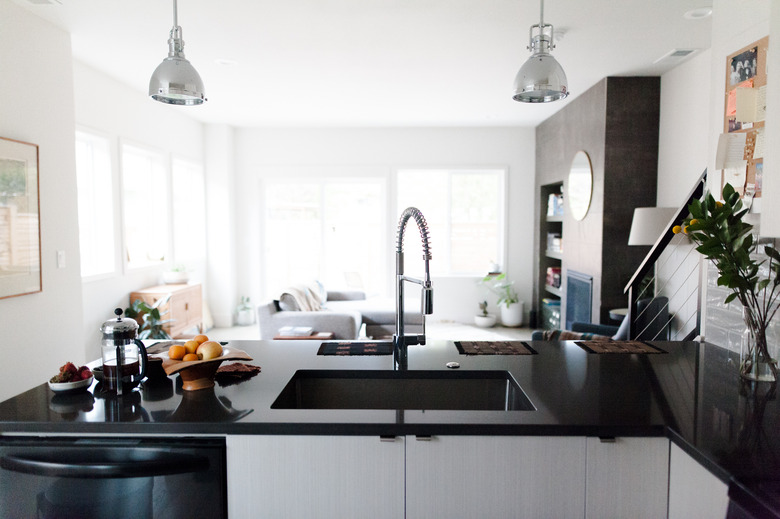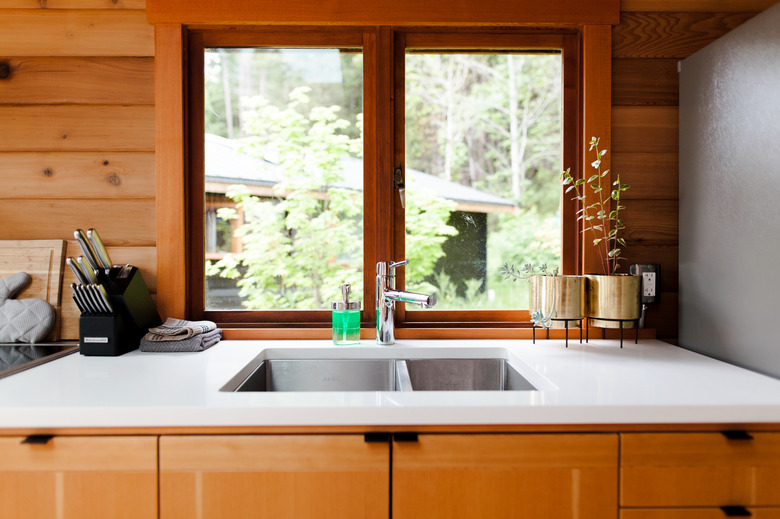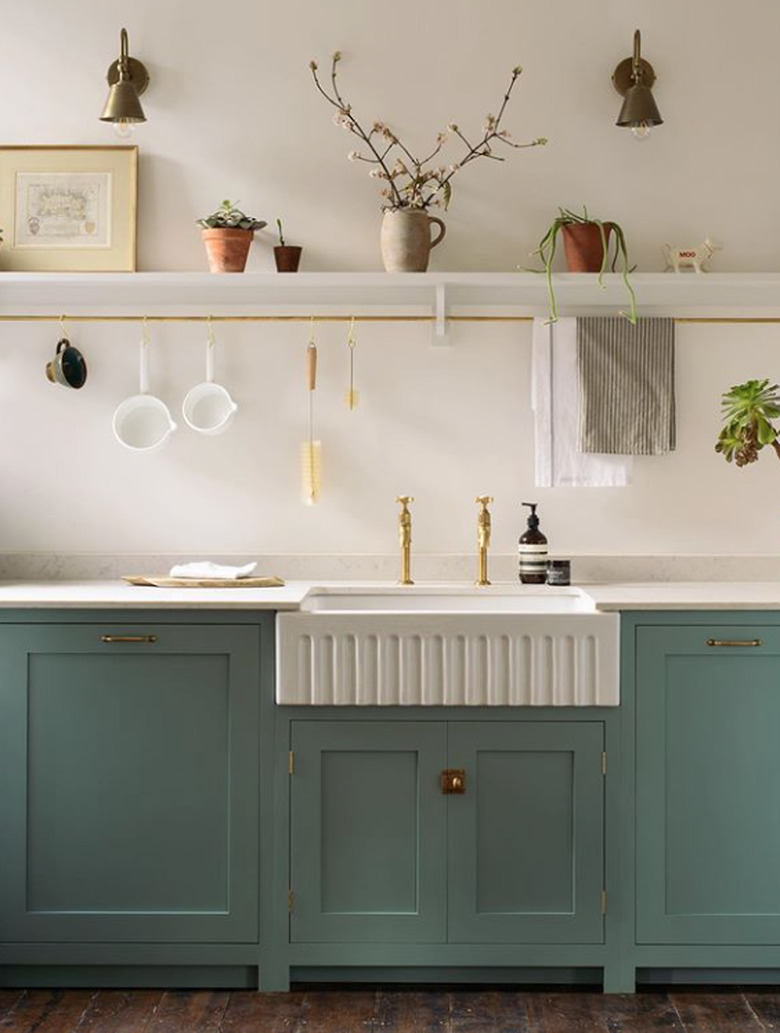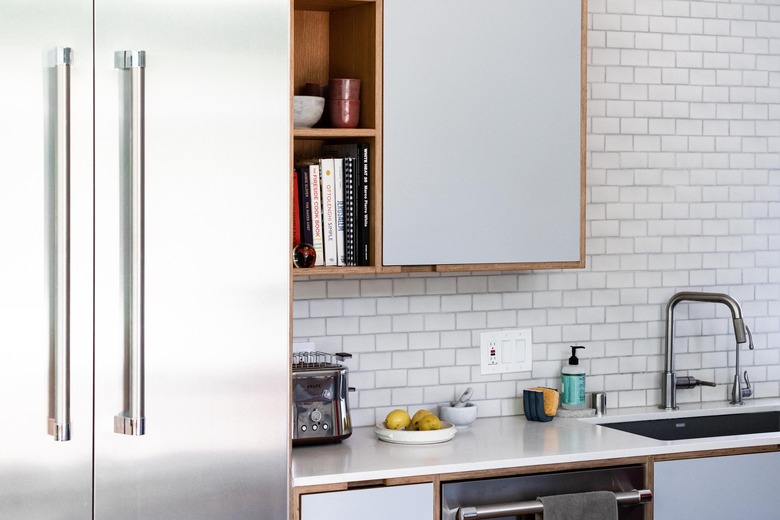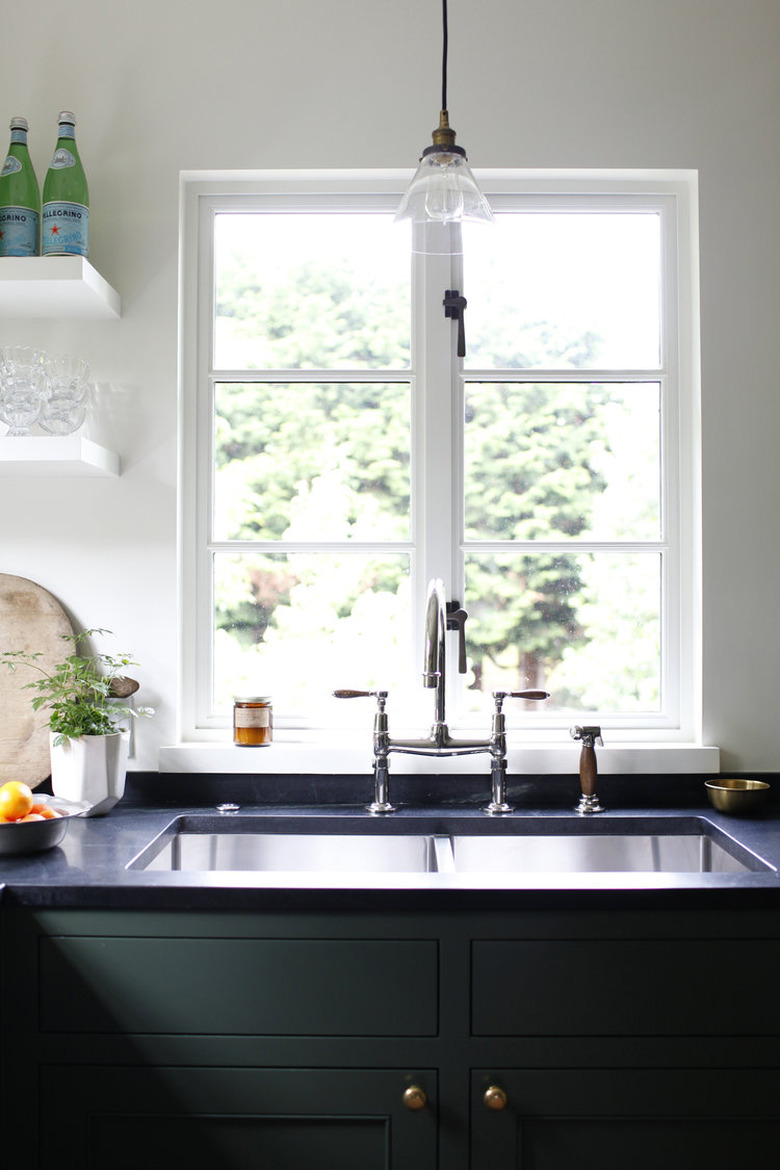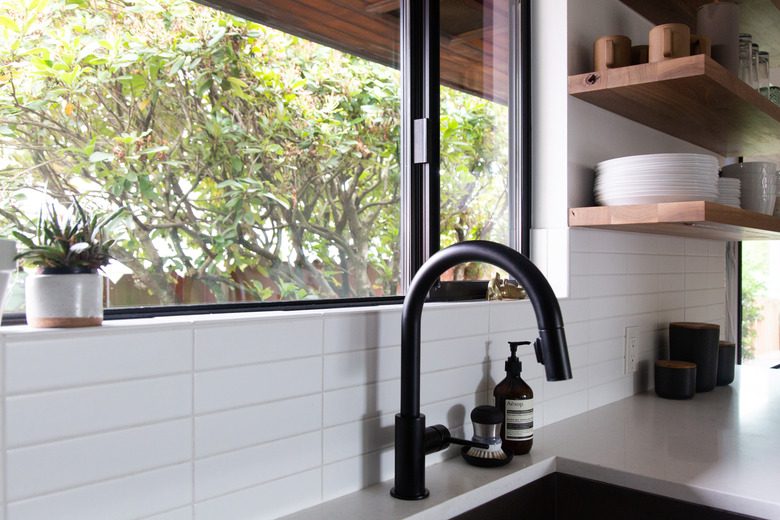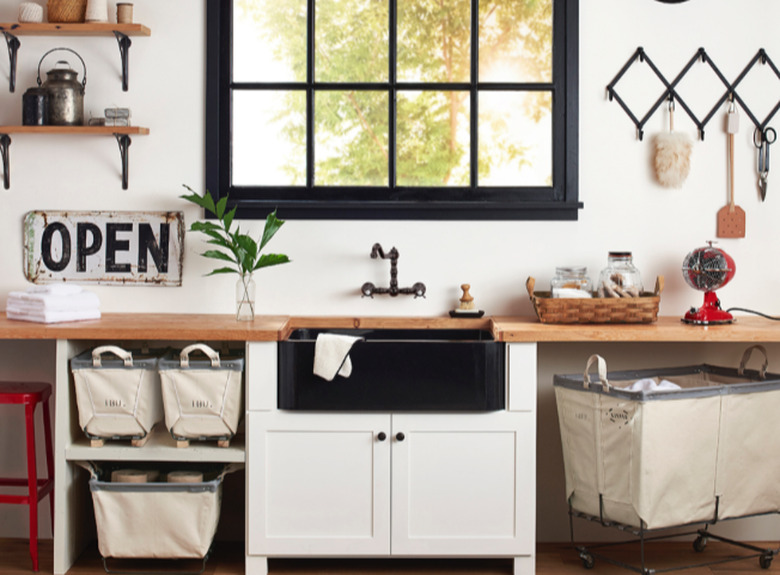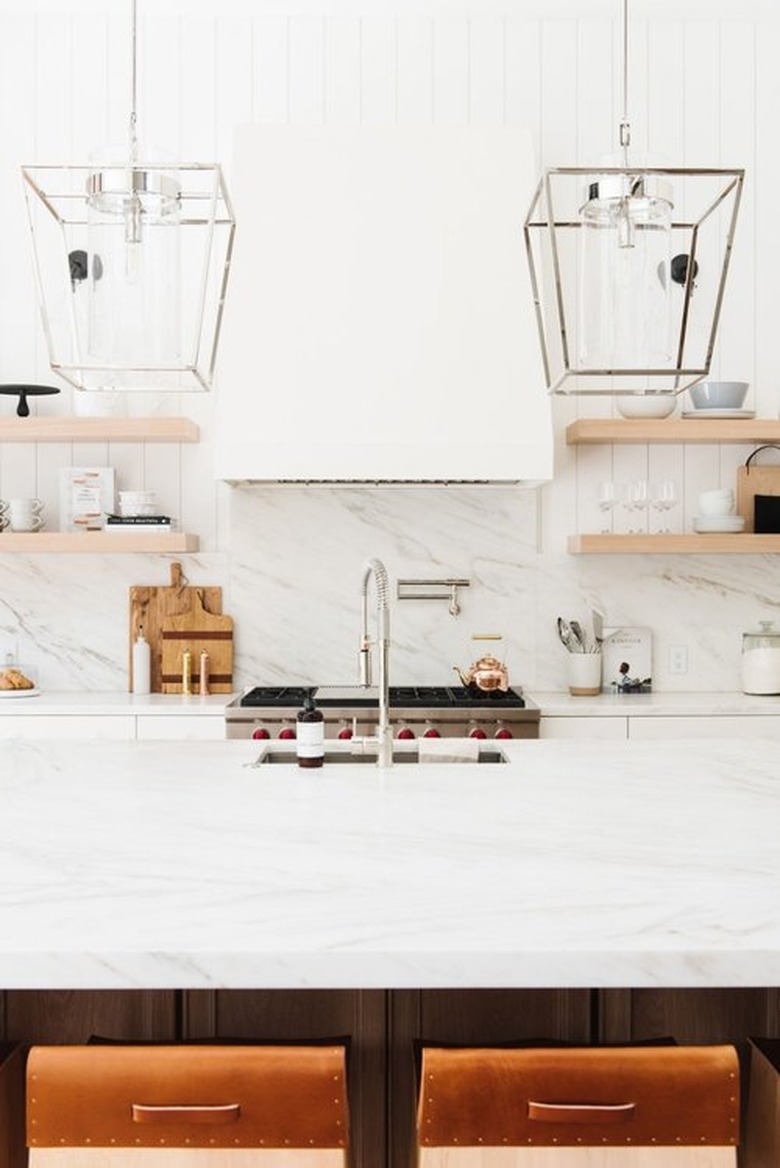Kitchen Sink & Faucet Ideas & Inspiration
They might not win the award for the sexiest design elements, but kitchen sinks and kitchen faucets are an integral part of a culinary space and deserve thoughtful consideration prior to purchasing. After all, is there any other area that sees more activity than the sink? We're talking: washing hands, washing dishes, filling pots, emptying pots ... you get the idea. You might not know it, but there are MANY different types of sinks and faucets available in a wide range of styles, materials, configurations, and price points.
When selecting these two unyielding features, be realistic about your cook space and work with what you've got. For example, will your sink play a starring role in a chef's kitchen? Or is yours more of a petite space that sees limited traffic? You don't want to install a small single bowl sink in a large kitchen because the proportions will be off and it won't be able to handle the workload. Conversely, an apron front double-sink will look out of place in a tiny galley kitchen. A bit of soul searching will help determine what type of sink and faucet will work for you. Of course, you want your sink area to be an ideal combination of form and function: it needs to look good, AND perform. Not too much to ask, right?
Different Types of Kitchen Sinks
Different Types of Kitchen Sinks
When it comes to narrowing down your kitchen sink selection, the first question you have to ask yourself is: Do you prefer a single-bowl sink or double? While looks are a big factor in making this decision, you should also think about the way you use your sink. Do you like to multitask in your kitchen sink, washing dishes on one side and rinsing on the other? Or, do you prefer to focus on one culinary task at a time? Also, consider the size of your kitchen. As previously mentioned, a large double sink might look odd in a small kitchenette.
Finally, think about the material of your kitchen sink. While stainless steel and porcelain are popular options, there's also the option of an integrated sink, which is made out of the same material as the kitchen countertops. While this look exudes sophistication and luxury, it can become a budget-buster and be difficult to replace if needed, so make sure to weigh the pros and cons.
There are three basic ways a sink can be installed: top-mount or drop-in sinks, undermount, and flush-mount. Read on to learn about the pluses and minuses of each.
Self-Rimming or Drop-In Kitchen Sink
Self-Rimming or Drop-In Kitchen Sink
Top-mount AKA self-rimming or drop-in sinks are the most common, not to mention, easiest (and most affordable) to install. They involve cutting a hole in your countertop (done by a professional) that will accommodate your sink and then "dropping" it in. Presto! Your sink is caulked with silicone for a watertight fit and held in place by a lip that overlaps on top of the counter.
Pros: This type of sink installation is the easiest to perform and generally the most affordable.
Cons: Due to the way the sink and counter meet, it is virtually impossible to sweep liquids or crumbs from the counter directly into the sink, and particles often get lodged at the intersection of the sink lip and the countertop. This type of sink installation also takes up valuable counter real estate, which is a negative, particularly in tight kitchens where every bit counts.
Undermount Kitchen Sinks
Undermount Kitchen Sinks
Undermount kitchen sinks hang from the underside of the countertop, or are supported from below by a base cabinet or clips. In this industrial kitchen, an undermount sink and no-frills single handle faucet practically disappears under a thick poured concrete countertop for a seamless design and plenty of surface space. Leanne Ford keeps the look clean and straightforward using a neutral color palette, exposed pipes, and a trio of oil-rubbed bronze pendant lights to enhance the look.
Pros: Undermount sinks allow food and other items to be brushed directly from the countertop into the sink without any "catch points," and they provide a streamlined aesthetic.
Cons: To support the weight of certain sink materials like cast iron or stone, undermount sinks require a well-designed mounting system. Translation: pricier to install. Although food won't get lodged around the lip of the sink as it can with the top-mounted variety, food can get stuck in the caulking where the sink and counter meet.
Integrated Kitchen Sinks
Integrated Kitchen Sinks
Integrated kitchen sinks are when the countertop transitions seamlessly into a sink made of the same material, creating a clean and smooth appearance.
Pros: Flush-mount installed sinks offer the same ease-of-cleaning benefits of an undermount sink with the added beauty of using a single consistent material.
Cons: The biggest con of integrated sinks is that because they are custom (no surprise here), they are expensive. They also present a unique challenge to replace if they are damaged or cracked.
Configuration: A sink's configuration refers to both the actual sink shape and size, as well as the accompanying faucet's characteristics. Since a sink and its hardware see so much use, it's important to purchase the best one you can afford. Pro tip: Before you shop for your faucet, you'll want to nail down your sink first because it determines how much reach you need your faucet to have.
Single Kitchen Sink
Single Kitchen Sink
Single bowl, as the name implies, is simply a one-bowl sink. This is a good space-saving option for smaller kitchens or for those who don't cook or entertain often. They come in a range of shapes and sizes from small and round to wide and rectangular.
Pros: Large single-bowl kitchen sinks are great for fitting oversize pots and pans and for saving counter space. They're typically more affordable than double-bowl sinks and are a great option for a secondary island or bar sink (if you roll that way).
Cons: They can make it more challenging to do dishes than a double bowl and can use more water and soap.
Double Kitchen Sink
Double Kitchen Sink
Double-bowl kitchen sinks are either one sink divided into two or two distinct sinks framed into one. Each side can be the same size and depth or one can be larger and deeper than its mate.
Pros: Double bowls allow for more flexibility in prep work and clean up, and promote water conservation since you can soak dirty dishes in one half. There are some fun accessories made for double bowls like cutting boards or colanders that can be used on one side.
Cons: They are difficult to install and therefore, you guessed it, pricier. The larger size means they're not ideal for smaller kitchens. And depending on the size of the bowls, washing larger items can be difficult.
Farmhouse or Apron Kitchen Sink
Farmhouse or Apron Kitchen Sink
Farmhouse or apron kitchen sinks are based on the original designs used in farmhouses before the advent of indoor plumbing when sinks needed to be deep and large to hold pumped water. Because farmhouse sinks jut out in front of cabinets and countertops, they make more of a design statement than other sink styles, something we consider a plus. The farmhouse style has seen quite a resurgence the last few years thanks to high-profile TV shows like Fixer Upper and, as a result, this option is now available in more materials and configurations than ever before.
It's hard to go wrong with a farmhouse sink (or a kitchen designed by deVOL Kitchens). Here, they selected an option with a corrugated front, adding a unique detail to a popular sink style. Deck-mounted faucets in antique brass and a wooden dowel for keeping oft-used items within arm's reach add to the charm and old world appeal of this space.
Pros: Their large capacity facilitates washing oversize pots and pans. They're very on-trend. Farmhouse sinks are more ergonomic because they extend past countertops, eliminating the need to lean over to reach the sink.
Cons: Some very tall people find the extra depth of a farmhouse sink uncomfortable since it necessitates reaching over more than for an average sink. Due to their extension beyond the countertop, as well as their depth, they require a custom cabinet below, making them a less than ideal choice if you're retrofitting an existing kitchen — unless you're willing to also replace the cabinet below.
Corner Kitchen Sink
Corner Kitchen Sink
Corner sinks help solve the riddle of awkward kitchen layouts by providing a solution that can only be placed at the corner intersection of two counters. They might not be your first choice but they make use of dead space and get the job done.
Pros: This sink style frees up valuable countertop space by maximizing dead corners.
Cons: Generally a corner sink will not have the benefit of being placed under a window, meaning no natural light while you wash dishes. There's only enough room for one person in front of a corner sink, making it impossible to recruit someone to dry while you wash. The space under a corner sink is pretty narrow.
Bar Kitchen Sinks
Bar Kitchen Sinks
Bar sinks are similar to a kitchen's main sink but on a smaller scale. They're used in conjunction with a primary sink and are often found in the island or bar area or larger cook spaces.
Got a minute? Let's talk about kitchen faucets.
Got a minute? Let's talk about kitchen faucets.
Yes. Kitchen faucets are a "thing" and come in a head-spinning number of options. They endure an incredible amount of wear and tear so you need it to not only look good, but be able to perform and last as well. It's important to make sure that the faucet's spout reaches the entire sink, and that the size of the spout works with the size of the sink. As with most things, faucets come in a wide range of price points, and price is a pretty good indicator of quality — expect to spend at least a couple hundred dollars for something that will hold up for 10 or more years, but faucet pricing can quickly go up from there.
Single Handle Faucets
Single Handle Faucets
Single handle kitchen faucets are a popular option. It's possible to get them in hands-free (when they're turned on by motion sensor) and pedal-controlled versions, which is a particular boon when hands are covered in raw chicken.
Pros: Ability to operate the hot and cold water with one hand while holding something in the other.
Cons: Some people find it difficult to control the water temperature.
Gooseneck Faucets
Gooseneck Faucets
Gooseneck faucets or high-arc faucets have a long arching neck or spout — typically 8 -10 inches tall — making them ideal for hand-washing large pots and pans, or if you're looking for more space to work with above the rim of the sink. Pro tip: If you have shelves, low cabinets, or a windowsill directly above/behind the sink, make sure to measure the space below to ensure your faucet fits.
Pros: Allows oversize pots and pans to be hand-washed easily.
Cons: Can impede the view of whatever is behind — be it sink, window, or tile.
Bridge or Two-Hole Faucets
Bridge or Two-Hole Faucets
Bridge or two-hole faucets have separate handles for hot and cold water, but a pipe joins the separate valves so there is just one faucet for the water temperatures. This style offers a classic, timeless aesthetic. Katie Hackworth uses a deck-mounted bridge faucet to add timeless design to a kitchen remodel. A single bowl undermount sink in stainless steel is a modern counterpoint to the traditional fixture.
Pros: They offer better water temperature control and are an elegant choice.
Cons: You need two hands to make flow and temperature adjustments.
Deck Mounted Faucets
Deck Mounted Faucets
Deck mounted faucets are installed directly into the countertop, not the wall or the sink itself.
Pros: This style involves a straightforward installation.
Cons: You'll need a professional to drill holes into the countertop.
Wall Mounted Faucets
Wall Mounted Faucets
Wall mounted kitchen faucets are just as they sound: mounted on the wall behind the sink instead of on the counter, freeing up valuable space. A wall-mounted kitchen faucet paired with a soapstone apron-front sink is a unique combination that adds plenty of character and charm to this high-style rustic space. Canvas bins, open wood shelves, and an oil-rubbed bronze accordion hook rack complete the look.
Pros: This type of installation keeps countertops clean and facilitates cleaning behind the sink since you don't have to work around the faucet base.
Cons: If your kitchen faucet installation will be on an outside wall and you live in a cold climate, you should consider going another route: water supply pipes in outside walls are prone to freezing. These faucets are also more expensive to install.
Pot Filler
Pot Filler
A pot filler above the stove is ideal for filling large pots with cold water used for soup, pasta, and other cooking needs without lugging them across the kitchen. This needs to be planned out early in your design phase and isn't easily added since you need to have a water supply in the wall.
A pot filler is a luxe perk for those who do a lot of cooking and put a premium on convenience. Shea of Studio McGee designed an elevated farmhouse kitchen with a gooseneck faucet, an abundance of marble, and chrome hardware. Open wood shelves flank the oven hood, and leather-detailed bar stools add warmth and texture.
Pro tip: Whatever faucet type you select, make sure there is enough room between the wall and faucet to ensure the handle(s) can swivel, or consider a single lever handle or handles that only swivel forward.
Pros: This one is pretty self-explanatory: A pot filler eliminates the need to lug a heavy pot full of water from the sink to the stove.
Cons: You'll still need to carry a heavy pot full of HOT water from the stove to the sink.
How smart is your faucet?
How smart is your faucet?
Kitchen faucets recently got an upgrade thanks to the introduction of Kohler's Sensate faucet, a newly released "smart" product that hit the market in August. The Sensate is voice controlled and pairs with Google Assistant, Amazon Alexa, and Apple's Siri.
Where to Shop for Kitchen Sinks and Faucets:
Where to Shop for Kitchen Sinks and Faucets:
Now that you know (almost) all there is to know about shopping for kitchen sinks and faucets, here are some places to consider for your purchases.
